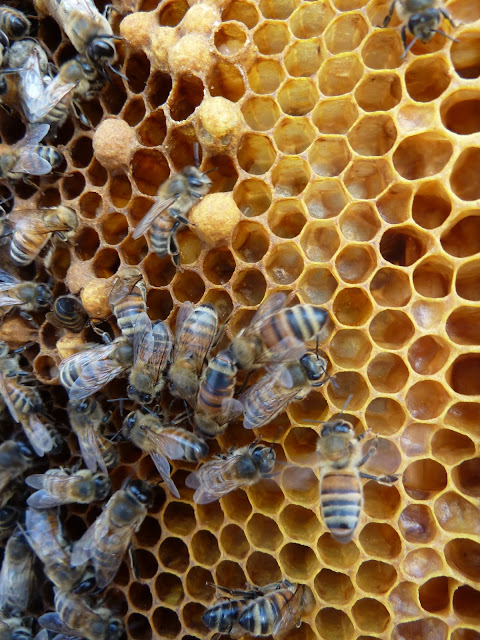Old Nucs - Yellow/Green hives:
These are the splits I made some time ago that were moved into full sized boxes last month. They've been feed 2 quarts of syrup each in the hopes that they would draw the empty frames with wax and start filling them up. If I found 10 good frames then I was thinking to take two nuc bodies (5 frames each) and stack them. It is suppose to be easier for the bees to move up in the winter and it would be easier for the bees to cover 5 frames at a time instead of 10.
Yellow Nuc:
I had suspicions during the last inspection that I had waited too long to transfer this nuc to a full sized hive and they decided to swarm (I saw some torn open queen cells). The bees seemed "flighty" and the only brood I saw were drones. The number of drones walking around the frames was high, especially since they should all be kicked out of the hive by now! I did spot some eggs and developing larva but something was telling me that this was not right.
 |
| Drones, lava and eggs but no queen |
So, either I have the start of laying workers or I have a queen laying all drones. On top of that, the bees had not touched a single new frame that I had placed into the hive. Stay tuned for more on the Yellow Nuc during my inspection of the Green Nuc....
Green Nuc:
I was a bit annoyed after pulling the first few frames since the bees had not touched them at all. Thankfully the original 5 frames that were moved into the hive looked pretty good. Lots of capped honey and worker brood! Two more frames in and I spotted the queen with her pretty green dot.
 |
| Queen with a pretty green dot |
I was even nicely surprised that after I moved past these 5 frames the bees were actually drawing out one of the new frames!
 |
| Drawing out a frame with new wax |
 |
| Festooning bees |
 |
| Newspaper combine complete |
 |
| Where did that orange pollen come from? |
This is my cutout hive that has made some really good progress over the summer. I removed the empty feeder jar and took a look through the top box. The bees were covering about 6 frames and had most of them drawn out.
 |
| Yellow Hive bees |
Quite a few were filled with capped honey. Looking down into the box below I saw lots of bees and some rubber bands still on the frames from the cutout!! They typically chew through them and dispose of them but I'm guessing they've propolised them right onto the frames now. I'll have to remove them during the first inspection in the Spring.
Green Hive:
The top honey super on this hive was filled with drawn combs that were completely empty. I thought for sure that when I added them that the bees would fill them quickly with the Goldenrod flow. No such luck. I pulled this box off after clearing a few stray bees off the frames. I pulled a few frames from the next honey super and at least there was some capped honey there. Looks like that box will stay on for the Winter.
White Hive:
Looking at the top honey super on this hive I could see that it was packed. I knew this from my last inspection but I had also seen a large pile of dead bees in front of the hive. I was concerned that this hive had been robbed out by other bees. Well not a single frame of honey appeared to be touched so this hive should have some great stores going into Winter. It also had a nice population of bees and when I looked closely at the pile of dead bees I saw numerous dead yellow jackets in the pile. Maybe they tried to raid the hive and picked the wrong one to screw with!
 |
| Battle aftermath |
I'm also considering getting or building some candy boards that come with a top entrance. This would allow the bees to leave the hive for a cleansing flight during the Winter if the bottom entrance happened to be plugged up with dead bees.
With four hives going into Winter and some diversified genetics (one Italian, one cutout wild open mated and two "northern" queens), I'm hoping to have some better luck overwintering this year. Wish for a mild Winter and wish the girls luck!
Until next time, thanks for reading!